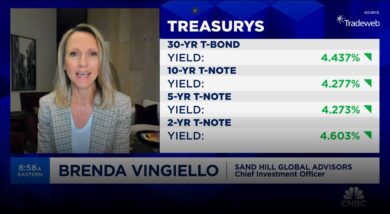Sand Hill's Chief Investment Officer, Brenda Vingiello, CFA, joins Jenny Harrington on “Halftime Report” to go over their most recent portfolio moves. Brenda's commentary begins

Shrinking Home Values to Enlarge Wealth Transfers
In the alphabet soup of estate planning jargon, the acronym QPRT is one of the more familiar — if not fully understood — terms and it represents a popular and rather common technique for potentially passing significant wealth amongst generations using family homes with little or no gift or estate tax consequence. The letters stand for Qualified Personal Residence Trust and these special types of trusts can enable significant valuation discounts and thus better utilize the application of one’s available Lifetime Exemption from gift and estate tax, depending upon the mix of various underlying circumstances such as the age of the grantor, the term or length of years for the trust, the current value of the property, and the applicable required interest rate (IRS section 7520).
The current overall available amount in 2017 for the Lifetime Exemption from Gift and/or Estate Tax is $5,490,000 per individual or a combined amount of $10,980,000 for two spouses. This means that a married couple can exempt up to almost $11 million over the course of their lifetimes or as bequests at death from gift and/or estate taxation. That amount does not include the unlimited annual exclusions which can also be given away by any individual each year to an unlimited number of recipients (currently $14,000 per recipient). Of course, any previous non-charitable lifetime gifting of any other assets would reduce the current available exemption amount that could be applied against the discounted gift of a QPRT—such as outright gifts of cash above the annual exclusion amounts or other deliberate wealth transfers such as GRAT’s or Intentionally Defective Grantor Trusts (IDGT’s).
Moreover, a QPRT only functions as a lifetime gift and thus cannot be achieved as a bequest. It also does not qualify for using the annual exclusion amounts. It therefore must be completed while the grantor is still living. If the grantor does not survive the term of the QPRT, then the home comes back into the taxable estate and nothing is accomplished. As such, it’s important to expect to outlive the chosen term of the trust. These trusts are “special” because they are only available for personal residences, and not for other investment real estate. These trusts are limited in use to only two personal properties per individual, and one of these must be the primary residence, or an undivided fractional interest in either. The second home — typically a vacation property — can be rented out by the grantor for a period of time each year, but there are rules that guide these conditions and the grantor is still required to use it, too. It is also best to plan to hold the house in the trust for the full term. It can be sold within the QPRT, but that gets more complicated. Also, if the property is subject to a mortgage, there will be greater complexity and, ideally, QPRT’s work best for unencumbered homes.
The essence of a QPRT is to try to discount (or shrink) the taxable value of the transferred property as much as possible and reasonable, and then, depending upon the resulting size of the discounted gift and the availability of one’s Lifetime Exemption, have no out-of-pocket tax bill due. The factors that affect the overall valuation are:
- Age of grantor(s) — the younger, the better
- Term of years for the trust — the longer, the better
- IRS Section 7520 rate — the higher, the better
- Current value of the property — the lower, the better
Due to the lack of any annuity or cash flow obligation, though, there is less reduction in the retained interest on a QPRT and thus — unlike some other estate planning techniques — a higher 7520 rate on a QPRT is actually desirable which is not currently the case given that interest rates have been, and remain, low. The Section 7520 rate that is used for all QPRT’s regardless of the length of the term is always 120% of the current midterm Applicable Federal Rate (AFR) at the time the trust is established. As of February 2017, that 7520 rate is 2.6%. And yet, the length of the term also influences the calculation of the taxable gift made by most estate planning attorneys or tax advisors.
Another important factor is the underlying value of current housing prices. In many locations, those values are once again relatively high unlike back in 2008 and 2009 during the “credit crisis” when similar QPRT’s could have been established to take advantage of the severe declines in real estate values all across the nation. So, it might presently seem that QPRT’s would not be that attractive. Still, overall discounting capabilities (which, again, also include the length of the term of the trust and the age of the grantor) are still possible and might still be compelling. Plus, if a sizable enough estate has few other assets that can be discounted in value — like any basic stock and bond portfolio that can only be valued at current market prices for purposes of any gifting — then the family home, or homes, might offer worthwhile opportunities to be more creative with overall tax and estate planning.
Here are a few examples that show a range of differences in resulting discounted gifts based on different circumstances; and even if the grantor was the same age in each example, it would still be possible to shelter both such homes with one’s individual Lifetime Exemption, even though the combined appraised value of both properties together is much higher.
Example A
Assume the house is worth $5 million (which is no longer such a stretch anymore in the Bay Area), the grantor is age 80, the QPRT is set up for a 9-year term, and the current 7520 rate is 2.6%.
-Age of grantor: 80
-Term of trust: 9 years
-IRS Section 7520 rate: 2.6%
-Current appraised value: $5,000,000
$1,674,550: Discounted value of the gift to QPRT
Example B
Now assume a second house — or perhaps even the same house above at a lower appraised value for whatever reason (perhaps a local economic downturn, even if just temporary), the grantor is younger at age 58, the term of the trust is now 25 years, and the 7520 rate is still 2.6%.
-Age of grantor: 58
-Term of trust: 25 years
-IRS Section 7520 rate: 2.6%
-Current appraised value: $3,500,000
$850,360: Discounted value of the gift to QPRT
An additional consideration, if applicable, is whether the gift is made jointly by a married couple and thus based on two lives. But this approach actually increases the amount of the upfront resulting taxable gift, since actuarially this makes it more likely that the gift will occur at the end of the given term (that is, the risk of death with two lives is lower). And thus, it is not common to create a QPRT based on two lives. Instead, a married couple should ideally create two QPRT’s – one for each of their 50% ownership in the same house.
Importantly, a QPRT is considered an irrevocable gift upon its establishment, and once the term is satisfied, the house is fully owned by the beneficiaries. However, during the term of the trust the grantor retains the right to use the property, and even after the trust expires the grantor can continue to occupy the house (if the beneficiaries agree) as long as fair market rent is paid to the new owners—presumably family members. Typically, though, due to obvious considerations, including a justifiable reluctance to give up control of the family house too soon, especially a primary residence that a grantor may hope to occupy for as long as possible — these types of trusts usually get put in place later in life, and often after the first spouse passes away. Besides, the death of a first spouse also enables a full step-up in cost basis on the entire property (at least in community property states like California), and this in turn will reset the clock on capital gains and provide that additional benefit in the overall competing mix of different types of taxes that need to be considered when transferring wealth.
As a result of the possible hesitancy to give up control of a primary residence or the desire to wait in consideration of a possible full step-up in cost basis on that same property before utilizing a QPRT it could be that a second home, if available, is the better choice for an initial QPRT. And this could, and perhaps should, be achieved much earlier in life. If so, a QPRT for a second home could conceivably be created using a much longer term of years for the trust which, in turn, would provide steeper discounts on the taxable gift amount. Plus, transferring the property sooner — especially on a vacation home that might be intended to be kept anyway and enjoyed for years by successive generations — would shift any future price appreciation on that same house out of the grantor’s estate and thus further help with overall estate planning.
After the initial term expires on a QPRT, the property will have successfully passed to beneficiaries or their trusts and presumably these beneficiaries are the children of the grantor(s). Again, if the parent(s) want to continue to live in the house, then they will need to pay a fair market rent to the new owners (the children). But this too is not such a bad situation, since this payment of ongoing rent will enable further effective estate planning as any such rent will both immediately benefit the new owners and commensurately reduce the value of the parent’s potentially taxable estate by an equivalent amount.
The grantor(s) also pays all homeowners insurance and property taxes during the term of the QPRT, and they also cover any normal maintenance and repairs during this period. However, any other major home improvements or remodeling would not be allowed because that would effectively enable the ability to pass an even more valuable asset than what was initially captured upfront in the calculation of the taxable gift; and thus, this should be clearly understood in advance, in case the grantor(s) had plans to alter the home for their own enjoyment after placing it in a QPRT.
Once the QPRT term is achieved (whether that is after a fairly short period like 5 years or something much longer like 20 years):
-the Deed to the property then passes fully to the new owners (again, presumably children);
-and at that point and going forward, all of those same basic household expenses—insurance, property tax, maintenance—become the sole obligation of the new owners (beneficiaries) for as long as the property is held.
-Fortunately, the required rent that will be paid by the occupant (parent) to the new owners (children) should be (more than) adequate to help cover these basic costs of ownership.
Furthermore, the property tax owed by the children after the QPRT term ends is typically consistent with whatever it had become under the grantor’s last year of ownership, including normal inflation adjustments though this outcome is ultimately dependent upon the county that the house is located in (and a successful QPRT effectively represents a full transfer in ownership). There are also other provisions in many tax codes — as there are in California — that can provide favorable continuity in real estate taxes on homes transferred between parent and children. So it is unlikely that a completed QPRT would trigger a significant change in property tax but this should be deliberately examined in each situation with the help of one’s tax counsel.
While everyone’s situation is unique — and requires careful individual attention and planning — in general, QPRT’s offer potentially attractive opportunities to shrink home valuations and enlarge wealth transfers. At Sand Hill Global Advisors, we work with our clients to consider such planning and possible action in conjunction with examining other needs and objectives, and the resources to provide for them. Please let us know if you would like to discuss your own personal situation.
Articles and Commentary
Information provided in written articles are for informational purposes only and should not be considered investment advice. There is a risk of loss from investments in securities, including the risk of loss of principal. The information contained herein reflects Sand Hill Global Advisors' (“SHGA”) views as of the date of publication. Such views are subject to change at any time without notice due to changes in market or economic conditions and may not necessarily come to pass. SHGA does not provide tax or legal advice. To the extent that any material herein concerns tax or legal matters, such information is not intended to be solely relied upon nor used for the purpose of making tax and/or legal decisions without first seeking independent advice from a tax and/or legal professional. SHGA has obtained the information provided herein from various third party sources believed to be reliable but such information is not guaranteed. Certain links in this site connect to other websites maintained by third parties over whom SHGA has no control. SHGA makes no representations as to the accuracy or any other aspect of information contained in other Web Sites. Any forward looking statements or forecasts are based on assumptions and actual results are expected to vary from any such statements or forecasts. No reliance should be placed on any such statements or forecasts when making any investment decision. SHGA is not responsible for the consequences of any decisions or actions taken as a result of information provided in this presentation and does not warrant or guarantee the accuracy or completeness of this information. No part of this material may be (i) copied, photocopied, or duplicated in any form, by any means, or (ii) redistributed without the prior written consent of SHGA.
Video Presentations
All video presentations discuss certain investment products and/or securities and are being provided for informational purposes only, and should not be considered, and is not, investment, financial planning, tax or legal advice; nor is it a recommendation to buy or sell any securities. Investing in securities involves varying degrees of risk, and there can be no assurance that any specific investment will be profitable or suitable for a particular client’s financial situation or risk tolerance. Past performance is not a guarantee of future returns. Individual performance results will vary. The opinions expressed in the video reflect Sand Hill Global Advisor’s (“SHGA”) or Brenda Vingiello’s (as applicable) views as of the date of the video. Such views are subject to change at any point without notice. Any comments, opinions, or recommendations made by any host or other guest not affiliated with SHGA in this video do not necessarily reflect the views of SHGA, and non-SHGA persons appearing in this video do not fall under the supervisory purview of SHGA. You should not treat any opinion expressed by SHGA or Ms. Vingiello as a specific inducement to make a particular investment or follow a particular strategy, but only as an expression of general opinion. Nothing presented herein is or is intended to constitute investment advice, and no investment decision should be made based solely on any information provided on this video. There is a risk of loss from an investment in securities, including the risk of loss of principal. Neither SHGA nor Ms. Vingiello guarantees any specific outcome or profit. Any forward-looking statements or forecasts contained in the video are based on assumptions and actual results may vary from any such statements or forecasts. SHGA or one of its employees may have a position in the securities discussed and may purchase or sell such securities from time to time. Some of the information in this video has been obtained from third party sources. While SHGA believes such third-party information is reliable, SHGA does not guarantee its accuracy, timeliness or completeness. SHGA encourages you to consult with a professional financial advisor prior to making any investment decision.
Other Posts By This Author
- – Fiscal Sponsorship for Charity
- – Risky Business
- – Emotional Rescue
- – Children in Cars Getting Coffee… or Anything Else
Related Posts







